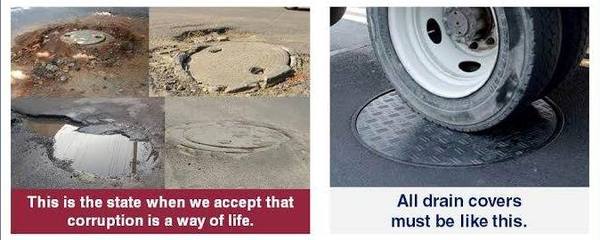
How hard it is to make a manhole cover that is LEVEL with the road? Not very hard, but no matter how many times this is pointed out, BWSSB never does this. I spent some time trying to figure this out, and learned three things.
A. BWSSB assumes that BBMP will keep raising the level of the road each time tar is added, so, the drain cover will be eventually level for a brief period However, any further raise in the road makes cover sink, and that too is visible in many places. BBMP could easily mill each road’s old tar and keep the new levels the same when it does its jobs, but that means fewer materials contracts in BBMP, so they don’t do that either.
However, any further raise in the road makes cover sink, and that too is visible in many places. BBMP could easily mill each road’s old tar and keep the new levels the same when it does its jobs, but that means fewer materials contracts in BBMP, so they don’t do that either.
B. The small works contractors in BWSSB have no engg skill – they basically know how to pour concrete and pat it down. They also have zero equipment – invariably, even the material they buy for a job are bought with advance contract money.
C. Making a bad manhole creates other jobs – of responding to various complaints about protruding manholes, which are then ‘repaired’ by spending even more money.
All this is totally avoidable. But technical specs apart, we need to entrust infra development in the city to a single agency, and not have it spread out over so many. Since BDA no longer has any planning powers, it can easily be converted into a Bangalore Infra Development Agency (BIDA) which holds accountability for all infra in the city. That would stop the passing of the buck that now happens.
Related Articles
Dear Chief Minister, take the first step in doing what is right for Bengaluru
Its not only the Manholes which we are left to manoeuvre but the BBMP is building the storm drains at almost every intersection at a height of almost a foot or a foot and a half. I really wonder which Engineering brain came up with this idea. Its so difficult to make a turn as all these are exactly at the intersections which in turn slow down traffic. Our city corporation is plagued with unscientific engineering methods.
Manholes not aligning with road surface is a serious safety issue, need to be addressed urgently. I have an idea – why not use stackable rings (which broder the manhole cover) or stackable slabs (to cover the manhole fully)? Manhole covers are standard size – hence it would be cost effective to manufacture such stacks and use them whenever needed. Just keep adding them when the new surface is laid, to match the height. I’m sure many such engineering solutions are possible.